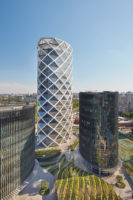At the Poly Grand Theater in Shanghai, Tadao Ando puts his flair for drama to good use. Starting with his usual Platonic geometry—here a 330-by-330-by-113-foot box—Ando bores large tunnels vertically, horizontally, and diagonally into the form. The move seems aggressive, more like coring an apple than forming holes in Swiss cheese. The cylindrical tunnels meet the concrete structure's aluminum-and-glass curtain walls at various angles to create elliptical shapes on all four facades. On the inside, the tunnels produce a similarly theatrical experience for visitors coming for operas, concerts, plays, and other events.
Ando's design features five “tubes,” each pushing through the 602,000-square-foot building and serving a specific function. Most visitors will encounter two of these elements— a six-story vertical lobby tube and a two-story horizontal foyer tube—on their way from the entrance to the main theater. The lobby is accentuated by two eye-catching stairways that curve left and right like showpieces out of a 1920s Broadway musical. A bridge on the fourth level and windows on the fifth overlook the grand space. The lobby's square ceiling somewhat diminishes the bold impact of the cylinder, but its intersection with a circular skylight creates the kind of dramatic daylighting for which Ando is known. From the lobby, the foyer tube skillfully compresses the visitor's experience, allowing for an explosion of space when entering the theater proper.
Three additional tubes—one leading to a covered, but not enclosed, amphitheater on the ground level; one for an amphitheater on the roof; and one connecting the south side of the site to the main foyer—are active mostly for specific occasions. The connecting tube will link to a forthcoming commercial complex to the south where Ando's design for a multiuse tower with hotel, office, and retail space is currently under construction. All of the tubes are steel-frame elements independent of the building's main concrete structure and have interior surfaces finished in aluminum rib-wall painted to look like wood.
Inside the 1,600-seat main theater, the cylindrical theme continues. Bands of laminated wood rib-wall at the orchestra level and up through two balcony levels provide a warm, textured contrast to the more subdued aluminum and exposed-concrete finishes in the bulk of the interiors. The theater's 12 box seats particularly revel in unabashed curviness. Sun Jian of China Poly Group, the state-owned conglomerate that commissioned the project, says he believes that the architectural acoustics of this project are the best of the many theaters his company has built around the country (see sidebar). Ando credits his acoustical engineer, Shanghai-based Zhang Kuisheng Acoustical Design and Research Studio, for collaborating in making sure the sound quality in the theater is excellent.
The building's main theater opened in September. A quiet water court off an indoor exhibition room on the fifth floor is also completed and exemplifies the serenity for which Ando is known. Many of the ancillary spaces—including a café, restaurant, and multipurpose hall—were not yet open at the time of this writer's visit in February. And the building's various covered terraces occupying the spaces inside some of the building's giant tubes were not in use: they were roped off, as “public” areas often are in China. It is difficult to predict how well they will be used.
It is similarly unclear how well the building will work as an icon for Jiading. Cultural centers can be important place-makers in new towns in China that lack churches, government halls, town squares, and other recognized nodes of urban life. But when every new building—from a theater to a shopping mall—tries to be unforgettable, the resulting cacophony can drown out even the strongest voice. Ando counters that the Poly Theater has enough landscaped areas around it that it will not be so affected by its neighbors. An even greater success would be that both the theater building and its public space are not only visually engaging but also physically active. Only in this way can any cultural complex become a real community center.
Patron of the Arts
Design Boom
China Poly Group, the client for the Shanghai theater, is probably best known for its auction house. Poly Auction is one of the largest houses in China and an integral force in the recent expansion of the Chinese art market. Yet the parent corporation is a wide-ranging enterprise servicing sectors as diverse as real estate, minerals, chemicals, and explosives. Poly was founded in 1992 as a state-owned enterprise (SOE), and its special relationship with the Chinese government no doubt has spurred its success. In 2012, the company's assets from all of its subsidiaries reached $62 billion.
Poly's headquarters in Beijing, designed by SOM, shows the prominence of its culture and arts division. The skyscraper features a ground-floor showroom for the auction house and a lantern-like museum projecting from the building's glass curtain wall. The museum houses an impressive collection of bronzes and Buddhist stone sculpture.
Poly collects architecture as well as art. It manages 39 theaters throughout China and has hired both foreign and Chinese firms to design them. In eastern China, the Finnish firm PES-Architects roofed the villagelike Wuxi Grand Theater with eight wavy forms. The French firm Arte Charpentier Architectes designed the Shanxi Grand Theater in the northern city of Taiyuan. Shanghai's Dushe Architectural Design wrapped the Yingkou Bayuquan Poly Grand Theater in Liaoning with a facade seemingly made of layered puzzle pieces.
Each of these theaters brings a concentration of architecture and culture to a newly developed site. It remains to be seen how well these venues will be used. Regardless, the designs of the theaters are attracting attention and helping to market Poly to millions of people in China.
RECORD
People
Client
Design Architect:
Associate Architect Engineers: Architectural Design & Research Institute of Tonji University (civil/MEP)
Consultants:
General Cordinator:
Construction Manager:
Construction: Size: 602,000 square feet Cost: Withheld Completion Date: August 2014 |
Products |


















Post a comment to this article
Report Abusive Comment